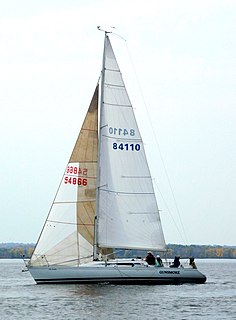Related Research Articles
The Catalina 38 is an American sailboat that was designed by Sparkman & Stephens as a racer-cruiser and first built in 1978.
The Bahama 30 is an American sailboat that was designed by Bob Finch as a cruiser and first built in 1973.
The Bristol 29.9 is an American sailboat that was designed by Halsey Chase Herreshoff as a Midget Offshore Racing Class and International Offshore Rule racer and first built in 1977.
The O'Day 30 is an American sailboat that was designed by C.R. Hunt & Associates as a cruiser and first built in 1977.
The Seafarer 30, also known as the Seafarer Swiftsure 30, is an American sailboat that was designed by McCurdy & Rhodes as a cruiser-racer and first built in 1978.
The Island Packet 35 is an American sailboat that was designed by Robert K. Johnson as a cruiser and first built in 1988.
The Southern Cross 28, also called the Gillmer 28, is an American sailboat that was designed by Thomas C. Gillmer and first built in 1978.
The Contest 32 CS is a Dutch sailboat that was designed by Dick Zaal as an International Offshore Rule racer to Lloyd's rules and first built in 1978.
The Morgan 32 is an American sailboat that was designed by Ted Brewer and Jack Corey and first built in 1980.
The Watkins 32 is an American sailboat that was designed by William H. Tripp Jr as a cruiser and first built in 1982.
The Pilot 35 is an American sailboat that was designed by Sparkman & Stephens as a racer-cruiser and first built in 1962.
The Seidelmann 37 is an American sailboat that was designed by Bob Seidelmann as a racer-cruiser and first built in 1980.
The Alajuela 33 is an American sailboat that was designed by Raymond Richards for cruising and first built in 1977.
The Baltic 37 is a Finnish sailboat that was designed by Robert W. Ball and C&C Design as an International Offshore Rule (IOR) racer-cruiser and first built in 1978.
The Dickerson 37 is an American sailboat that was designed by George Hazen as a cruiser and first built in 1980.
The Islander 40 is an American sailboat that was designed by Doug Peterson as a racer-cruiser and first built in 1979.
The Endeavour 40 is an American sailboat that was designed by Bob Johnson as a cruiser and first built in 1981.
The Nimbus 42 is a Swedish sailboat that was designed by F. Michael Kaufman and Robert Ladd as a cruiser-racer and first built in 1981.
The Irwin 41 is an American sailboat that was designed by Ted Irwin as a cruiser and first built in 1982.

The Beneteau First Class 10 is a French sailboat that was designed by Jean Marie Finot of Groupe Finot and Jacques Fauroux as a racer/cruiser and first built in 1982.
References
- 1 2 3 4 5 McArthur, Bruce (2019). "Southern Cross 35 sailboat". sailboatdata.com. Archived from the original on 4 April 2019. Retrieved 8 January 2020.
- ↑ Browning, Randy (2019). "Thomas Gillmer 1911 - 2009". sailboatdata.com. Archived from the original on 7 June 2019. Retrieved 8 January 2020.
- 1 2 3 4 5 6 7 8 Sherwood, Richard M.: A Field Guide to Sailboats of North America, Second Edition, pages 274-275. Houghton Mifflin Company, 1994. ISBN 0-395-65239-1
- ↑ Browning, Randy (2019). "CE Ryder". sailboatdata.com. Archived from the original on 4 April 2019. Retrieved 8 January 2020.
- 1 2 3 Glover, Rodney (September 2008). "Southern Cross 35". Archived from the original on 17 October 2018. Retrieved 8 January 2020.
- 1 2 Boothby, R. (20 July 2015). "Southern Cross 35". Blue Water Boats. Archived from the original on 17 October 2018. Retrieved 8 January 2020.